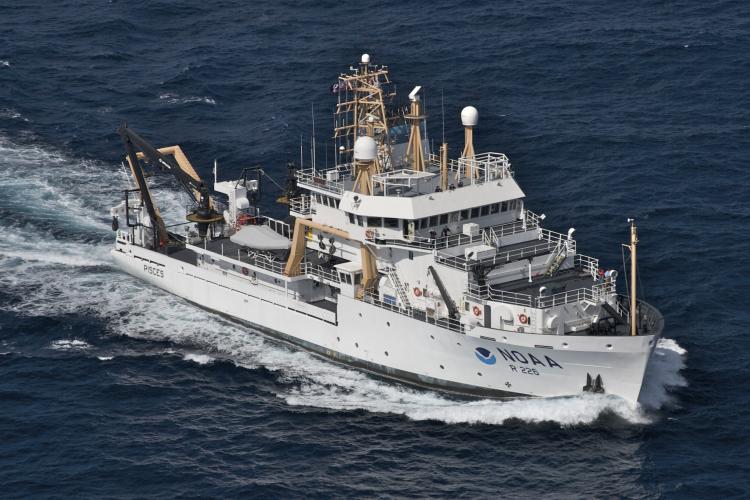
Credit: NOAA
Specifications
Contact Info
Pascagoula, MS
United States
About the ship
NOAA Ship Pisces was built by VT Halter Marine at Moss Point, Mississippi. The ship was commissioned on November 6, 2009 and is currently homeported in Pascagoula, Mississippi. Pisces is the third in a class of state-of-the-art acoustically quiet fisheries survey ships built for a wide range of living marine resource surveys and ecosystem research projects. The ship focuses primarily on U.S. waters from the Gulf of America (formerly Gulf of Mexico), Caribbean, and South Atlantic to North Carolina.
Constructed to meet the National Marine Fisheries Service's specific data collection requirements, the stern trawler is suited for shrimp trawling, longlining, plankton and reef fish sampling, midwater trawling, bottom trawling, acoustic surveys, and oceanographic and hydrographic operations.
The 208-ft. Pisces is capable of trawling in depths of up to 6,000 feet. Two extendible boom cranes service the working deck with each crane capable of lifting 8,000 pounds. The cranes dump the nets onto the sorting bin and a conveyor belt transfers the catch from the bin to the ship’s fish laboratory for sorting, weighing, measuring, and determining sex and age.
When conducting acoustic surveys, the ship uses a multibeam echo sounder (MBES) that projects a fan-shaped beam of sound that bounces back to the ship. Pisces’ MBES acquires data from both the water column and the sea floor. Scientists can detect fish as the ship passes over them, measuring the signal reflected by the fish to estimate their size and numbers. The system can also map and characterize the sea floor.
The ship’s marine mammal and seabird observation stations are equipped with sensors to aid researchers in identifying and tracking protected species.
Pisces’ “quiet hull” helps the ship meet International Consortium for Exploration of the Seas standards for reducing underwater sound. The ship is also equipped with a retractable centerboard that houses acoustic transducers that--when extended--allows researchers to collect data away from hull-generated noise. These quiet features reduce animal behavior changes caused by ship noise.
Pisces displayed her versatility during NOAA's response to the Deepwater Horizon oil spill in 2010. Her multiple missions included surveying reef fish, bottom-dwelling fish, and shrimp to sample seafood and water quality to assess the severity of the oil spill. As a part of the Deepwater Horizon Natural Resource Damage Assessment, investigators onboard Pisces collected data on fish and invertebrate samples to evaluate the condition and abundance of fish stocks.
The ship was named Pisces — the Latin word for the plural of “fish” — by five seventh grade students from Sacred Heart School in Southaven, Mississippi. The team won a regional NOAA contest to name the ship by submitting a winning essay.

